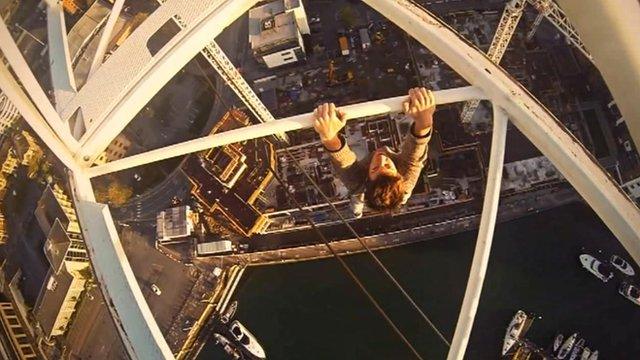Rooftoppers: The urban explorers risking arrest and worse
- Published

Esty Tomas, James Kingston, Matt Adams are among the country's best known so-called 'rooftoppers'
They are the "rooftoppers" - young men risking their lives climbing cranes, bridges and skyscrapers to film stomach-churning videos that thousands cannot bear to watch, but cannot turn off either. So why do they do something which is not only insanely dangerous but also illegal?
Looking straight down from the top of a crane hundreds of metres up and without safety gear, James Kington is calm.
"There's no adrenaline. It's just pure bliss - there's nothing but you and that bar in front of your fingertips," he says.
In 2013 he posted a video of sunrise over Southampton shot while walking out along the horizontal jib of a 96m (314ft) building site crane.
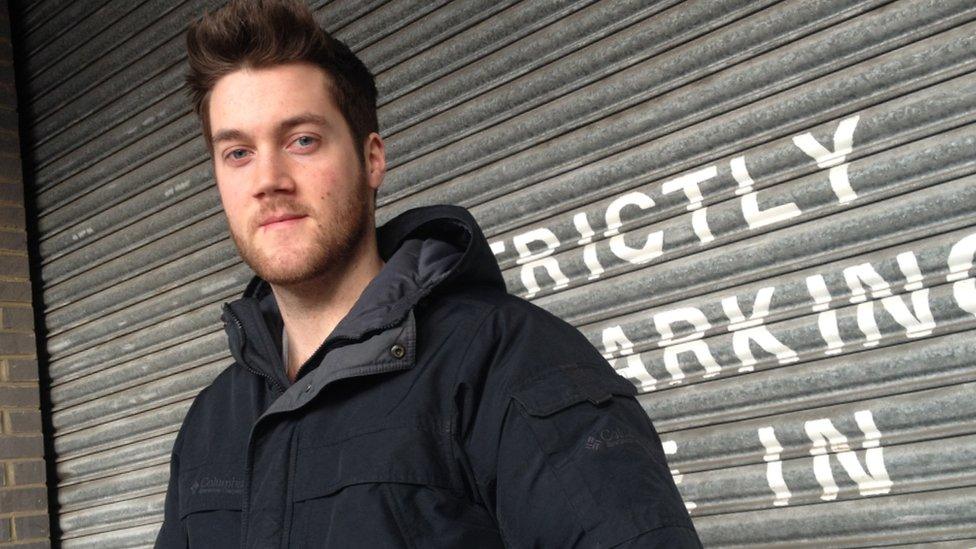
James Kingston admits he grew up with a fear of heights before he got into Parkour
Yet despite the danger, he trusts in his reflexes and decision making to stay alive.
"The moment you start wearing safety equipment is the moment you've got doubt and when you've got doubt, that's when things can go wrong," he adds.
"It completely changes the way you look at things. You see everything as a possibility rather than walls restricting you."
The 25-year-old from Southampton now makes a living from what he describes as an "art form", posting highly polished point-of-view videos of climbing the Eiffel Tower, Moscow Bridge in Kiev or Marina 101 in Dubai to a YouTube channel which has more than 250,000 followers.
He travels the world to perform climbing stunts for high-profile corporate clients as well as selling photographs and merchandise from his climbs.
James Kingston climbed on Marina 101 in November
James Kingston posted footage taken high on the Eiffel Tower in Paris.
Only a few years ago he was a shy teenager who was scared of heights.
"I ended up quitting school I had so many problems. There was a period where I did nothing but play computer games - I was super unhealthy, a bit chubby, with not many friends."
His life changed when he saw a BBC One promotional trailer featuring David Belle, the acknowledged guru of a new urban sport in France known as Le Parkour - or obstacle-coursing.
"I made a conscious decision to conquer my fear of heights and start climbing things."
Matthew Adams 23, has experienced the downs, as well as the ups, of "rooftopping". Two years ago he fell 30ft (9.14m), breaking seven bones.
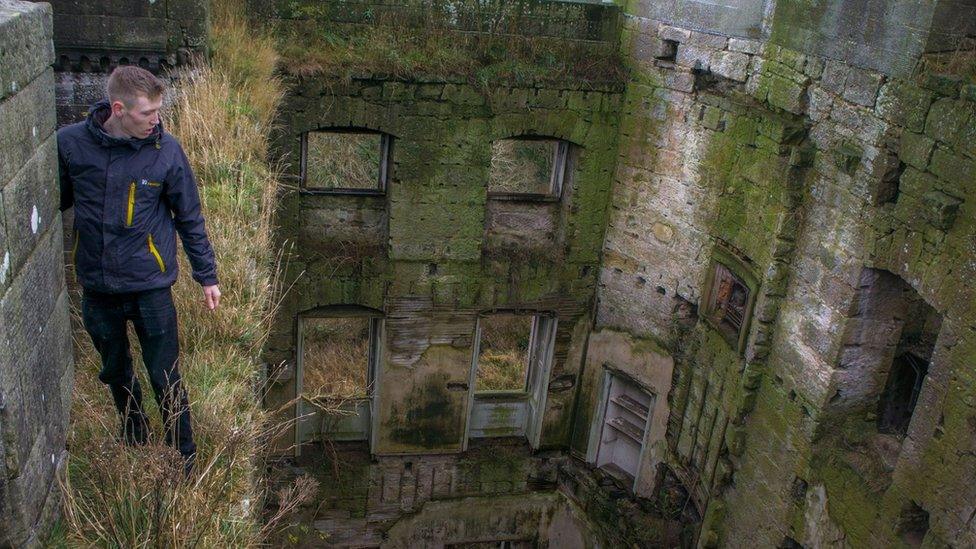
Matthew Adams has scaled buildings across the country and Europe
Earlier this month he, along with three others, were fined and banned from climbing man-made structures after being arrested in his home town of Lowestoft, Suffolk.
They were charged with the offence of threatening behaviour for causing alarm and distress to residents. Officers said they feared the climbers "may have fallen and not only killed themselves but innocent passers-by on the ground".
Ironically Mr Adams claimed police action would help the activity thrive in the long term.
"In my eyes it's given me a couple of years to train harder. Hopefully there will be more bans which will lower the attention on it and leave it for the few who are really passionate about it."
He said he positively discourages copycats for the same reason.
"It's like any extreme sport - skiers, mountain bikers, formula one drivers - they all have injuries and all get back up - but they aren't frowned upon like we are.
"Anything on social media will always have the risk of being copied.
"I always discourage people - it's something to learn yourself. Even if people ask for advice or places to climb, I don't give any advice so I can't feel guilty about it."
The Crown Prosecution Service refused to comment on the legal status of "rooftopping".
However, the risks are significant. A Russian teenager, Andrey Retrovsky, reportedly died last year after falling nine storeys while trying to taking an Instagram selfie from a block of flats in the city of Vologda.
"An appetite for adventure is fine - commendable even - but done in the right context," says David Walker, leisure safety manager at the Royal Society for the Prevention of Accidents (RoSPA).
"The bottom line is that if things go wrong, it does not only impact on the individual involved but also their family, the emergency services and staff who work at the construction and demolition sites."
However, Esty Tomas, another prominent UK rooftopper, says he never takes "unnecessary risks".
The 21-year-old achieved a level of fame in 2015 after he scaled Liverpool's Unity Building.
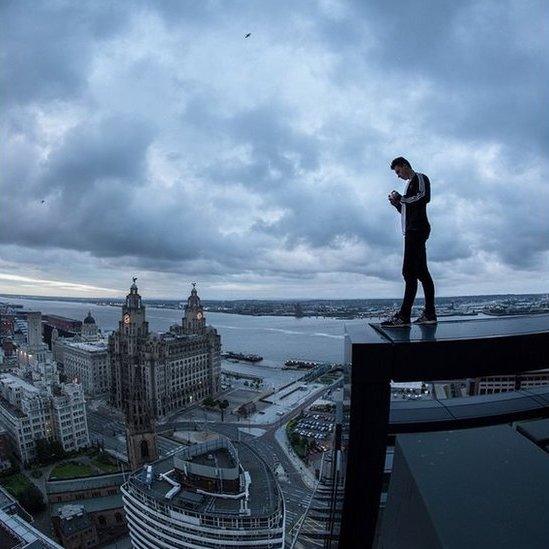
Esty Tomas published photos taken from the top of Liverpool's Unity Building.
"I'm not a person to risk my life, I'm not a reckless person," he says.
"I want to be alive as much as the next person. It's just how I'm choosing to live my life.
"There's always that care - you can't just jump on to things - not where your life's concerned."
Mr Tomas insists there is no rivalry with other rooftoppers spurring them to take greater risks.
"The competitive side is just not part of it - it's just cool."
Dr Bradley Garrett, of Southampton University, has studied the development of "rooftopping" - from its roots in the US to high profile stunts in China and Russia.
"Most rooftoppers develop a kind of tunnel vision - seeing a metre-wide beam as no different than a meter-wide pavement. You would not fall off the pavement so why would you fall off the beam?" he says.

Is 'rooftopping' legal?
"Whenever anyone enters land or buildings without permission of the landowner or occupier, they may become a trespasser.
"In most cases trespass is a civil and not a criminal matter, meaning the landowner could sue the trespasser.
"If the trespasser inadvertently caused damage to the property, the owner could sue for damages.
"Trespassing on to some types of land does constitute a criminal offence.
"Railway land is an obvious example.
"Trespassing on land owned by sensitive government establishments may be an offence.
"This could result in a hefty fine or up to six months imprisonment."
Dr Mark Wilde, associate professor, School of Law, University of Reading

He estimates there could be up to 300 active rooftoppers in the UK, but with climbers' social media channels commanding vast audiences, he believes it has also turned from artistic exploration into "an exercise in bravado to garner attention".
"A slew of other companies are now trying to 'capture' the urban explorer aesthetic to sell products," he says.
"Obviously now that there is money involved, people are more willing to take physical and legal risks to build up the social media profile that might lead to an offer of sponsorship."
However, Mr Kingston says this is not his motivation.
"It's not all about videos, its about the experience. Otherwise it becomes more of a chore to make a video to release - I want it to remain my passion as well as my job."
The Guinness Book of Records, unsurprisingly, has no record of the highest unsupported climb of a manmade structure.
However, the trend appears to be here to stay.
With "at least 20" videos of unseen climbs on his hard drive, there will be no doubt be plenty more more footage of Mr Kingston hitting the internet.
"I love creating things that open peoples eyes and inspire them - that's what it's about.
"I do have terrible trouble getting insurance," he added.
- Published15 March 2016
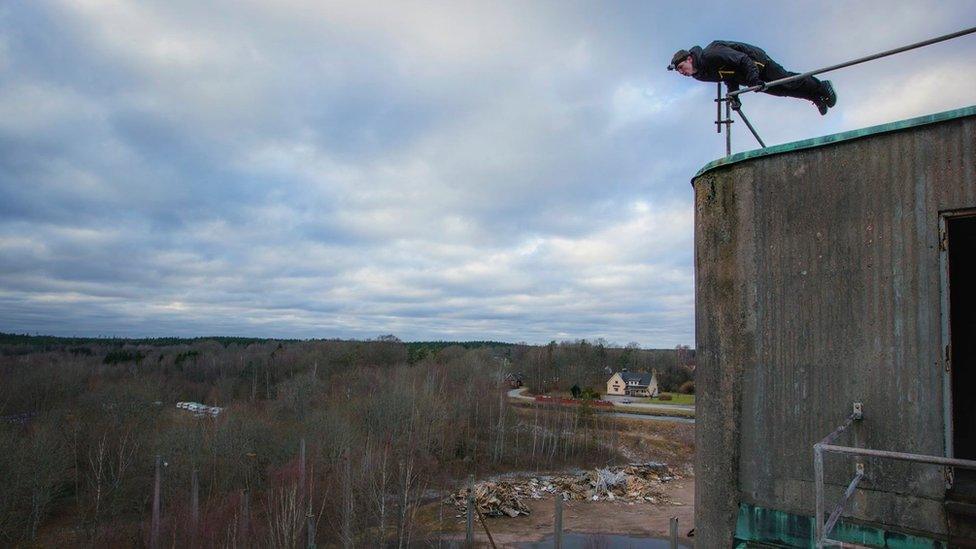
- Published9 June 2015

- Published5 June 2013
